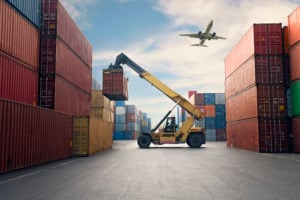The Retail Roller Coaster: Stuck Between Bottlenecks And Bullwhips

This article was originally published on Forbes
The retail industry is currently stuck between a rock and a hard place, or rather a bottleneck and bullwhip, as transportation and manufacturing delays continue heading into 2022. How did we get to this point in the first place, and how do we move forward?
By Land, Air And Sea
Retailers felt the effects of transport costs and constraints even before the pandemic. The American Trucking Associations (ATA) reported a shortage of 60,800 drivers in 2018 and anticipates it will surge to 160,000 drivers by 2028. To attract people into the profession and keep current drivers, trucking agencies are offering higher wages, which will in turn be passed down as higher transportation costs for retailers — and potentially higher costs to the consumer.
Covid-19-related supply chain disruptions began in early 2020 and have only grown worse since. As more people have stayed home, commercial airline traffic has taken a nosedive. With significantly fewer flights, there is significantly less opportunity for retailers to rent cargo space to transport their goods in the sky. McKinsey predicts that air traffic won’t return to 2019 levels before 2024, so the effects will likely continue to impact retailers for years to come.
The next wave of the logistical plague happened in March 2021, when an estimated 12% of global trade that typically flows through the Suez Canal was halted for six days by a massive container ship stuck in a shipping lane. With ships running at full capacity, the industry can’t simply make up for lost time. Retailers are still feeling the lingering effects.
To add insult to injury, there was a record pileup of container ships off the ports of California, New Jersey, New York, Texas and Georgia this fall due to a shortage of workers and equipment to offload and move them. This, at a time when the bullwhip effect is in full force — consumers want products and retailers are importing goods at record rates to restock depleted inventories.
In desperation to meet demand, Walmart, Target, Costco, Ikea, Home Depot and Dollar Tree have chartered their own container ships to bring products from overseas to the U.S. In addition, Walmart announced in September 2021 that it is planning to hire 20,000 new supply chain associates across its Walmart and Sam’s Club distribution centers (DCs), fulfillment centers (FCs) and transportation offices.
What now?
Unfortunately, there is no way to magically flip a switch and overcome this convergence of factors.
While major retailers can lease space on ships or flights in the coming months to transport high demand products, these transportation modes do not have unlimited capacity and they can only travel so fast. Additionally, the price for transport is skyrocketing and smaller retailers are simply priced out.
Most of the retail sector will have no choice but to slowly crawl out from this crisis. What can they do? There’s not much retailers can do to address inventory shortages in the short term. They likely tried to address these issues in early in 2021 but failed due to manufacturing plant shutdowns and supply chain blockages.
What retailers of all sizes can do right now is focus on their customer service efforts.
When a customer reaches out to your company in frustration wanting to know the status of the gift they ordered for their eight-year-old, the last thing you want is for a member of your team to respond, “I don’t know.”
My advice to retailers stuck in between the bottleneck and bullwhip is to anticipate the challenges, crafting your responses and preparing your call centers and customer care associates to handle the tough questions posed by customers when faced with delayed deliveries and product unavailability. Get your social media ready as well; customers are likely to turn to these channels when looking for answers. Be proactive and over communicate with your customers — set expectations.
Be judicious with your existing inventories. Constantly monitor and determine what inventory is available-to-promise and how it lines up to demand signals. Retailers need to take into consideration what their true fulfillment capabilities are as well. Just because your customers can order a product does not mean your infrastructure can handle that fulfillment capacity; taking orders without a means to fulfill them is a fast and surefire way to dissatisfy your customer base.
Finally, ensure your internal resources are aligned. From your supply chain team to sales to marketing to customer service, your internal teams need to work in lockstep from messaging to strategic initiatives.
We, everyone from retailers to consumers, need to take a deep breath. Disruptions are the only constant when it comes to our supply chains. Supply chains are resilient, and in the long term, they will normalize. But that might not satisfy the eight-year-old when she doesn’t get her birthday gift. In these cases, an ounce of prevention is worth its weight in freight.




